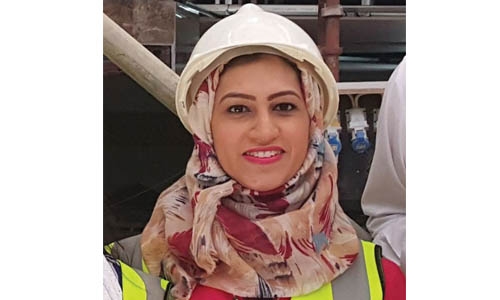She never gave up her dreams
Today, as we celebrate Bahraini women in the field of engineering, a field that has been referred to as a “masculine work environment” throughout the years, especially in conservative societies such as the ones of countries in the Arabian Gulf region, a visible increase of female engineers, have been noticed in recent years. More women are seen with their helmets and safety boots on, while on work sites performing different tasks required by their jobs, that could be in the fields of architectural, aviation, civil or mechanical engineering.
In line with the theme of this year’s Bahraini Women’s Day that was announced by HM the King’s Wife and Supreme Council for Women Chairperson HRH Princess Sabeeka bint Ibrahim Al Khalifa earlier this year to celebrate Bahraini women in the engineering field, DT News has spoken to a few Bahraini female engineers of different specialisations.
This includes Nada Fardan, a Bahraini architect who shared with us the main highlights of her journey in the field during the past decade and shed light on some of the main challenges that could face Bahraini women in this field.
‘An eyebrow raiser’
“It was back in 2003 when I graduated from high school and wanted to continue my higher studies in a field that would enrich my artistic and philosophic tendencies. I was one of few girls to enrol in the architectural engineering college at the University of Bahrain that year. It was an eyebrow raiser for many students of our generation, as for years it was believed that this specialisation is limited to male students. Some of our colleagues of both genders even attempted to talk us out of it. But we insisted on continuing this journey and proving ourselves worthy of bearing the responsibilities of an architect. We studied, worked hard and succeeded at last,” says Fardan.
According to Fardan, architectural engineering is more attracted to women in comparison with the other fields of engineering, as she says, “It revolves around beauty, sensitivity and creativity, which are more appealing to females if compared with males who are believed to be attracted to practical jobs”.
Fardan recalled: “The Education Ministry and the Higher Education Council in the Kingdom had organised more lectures and seminars at that time with the aim of attracting more female students to continue their studies in different specialisations in the college of engineering”.
“This was to cover the gap in the labour market created by the lack of women in certain fields, and to assist Bahraini students in discovering more work opportunities,” Fardan said, adding that acknowledging the gap between males and females in the field of architectural engineering encouraged her to choose it as a career.
She mentioned that the students were prepared to enter the market in the college, as their assignments included field training and site visits. This, she said, has greatly assisted them as Bahraini women engineers.
Pay gap matters
Speaking about the main challenges facing women in this field, Fardan affirmed: “The pay gap between genders has been the main obstacle for women engineers across the world, including Bahrain”.
However, she also underlined that “with the establishment of the SCW, the key women empowerment and rights supporter in the Kingdom, the issue has been gradually diminishing”.
She also mentioned “the competition of non-Bahraini engineers in the labour market and the gap in wages and work conditions between the private and public sectors” as some of the difficulties.
Acceptance growing
When asked about the eternal debate on men and women’s efficiency in certain work environments, Fardan commented, “Granting women equal opportunities to prove themselves in job fields such as architectural engineering had positive impacts on the results of the work. The nature of architects’ work is to supervise other engineers of different specialisations, such as electrical, civil and mechanical engineering. It was difficult in the beginning for men to take orders from a woman, especially in the constructions field, but I have sensed the acceptance from my male colleagues gradually grow through the years. This integration in the work environment has remarkable results on the perfection of projects.”
While sharing some of her aspirations as a Bahraini female architect, Fardan said one of her dreams is to design a monument dedicated to the Kingdom of Bahrain that “would last as a landmark for the next generations to witness”.
Fardan expressed her gratitude to the SCW, spearheaded by HRH Princess Sabeeka, for shedding light on the Bahraini female engineers and their contributions to the prosperity and development of the Kingdom, adding that “such an appreciation of women working in this field would sure motivate more female students of the next generations to get involved in it”.
Nada Fardan congratulated Bahraini women on the occasion of the annual Bahraini women’s day and expressed her pride in belonging to this nation. She also thanked her family members and friends for supporting her throughout the years.
Related Posts

